What Einstein and Bill Gates Teach Us About Time Travel

Time travel has long been a staple of science fiction books and movies. But will we ever be able to build a time machine and beam ourselves backward and forward in time in real life?
In some sense, of course, we’re all time travelers: We move forward in time from one minute to the next. But going back in time, whether to avoid some mistake or perhaps to repeat it, is something far more elusive. And for those who yearn to see what the world will look like a century or a millennium from now, the slow tick of your watch as time passes just doesn’t cut it.
The theoretical underpinnings of time travel date back to 1905, when Albert Einstein wrote down his special theory of relativity that showed space and time are intimately linked, and to 1916, when Einstein’s general theory of relativity showed that space and time are malleable — that is, they respond to the presence of matter or energy by warping, bending, expanding, and contracting. By extension, this means if one can imagine space being filled with some exotic form of energy, then space and time could warp in a way so that time, as well as space, could bend back upon themselves like circles, allowing one to move forward in a straight line and still return to one’s starting point in both space and time.
Related: Waves May Let Us See the Big Bang's Earliest Moments
But even after thinking about the time travel problem for more than a century, physicists haven’t advanced the ball very far. We recognize that while Einstein’s equations do allow for round-trip time travel (at least in principle), other physics considerations probably rule out creating the exotic forms of energy that would make it possible.
The first person to write down a mathematical solution of the general relativity equations that described an exotic type of space-time that might permit time travel was mathematician Kurt Gödel, a close colleague of Einstein’s at the Institute for Advanced Study in Princeton, N.J. He presented his result in a scientific paper that he gave Einstein as a birthday present on his 70th birthday in 1949.
But just being able to determine that general relativity allows configurations of space and time in which forward or backward time travel is possible doesn’t mean those configurations can actually be created. Since general relativity implies that the configuration of space-time is determined by the nature of the matter and energy within it, one needs to determine whether it’s possible to create the appropriate type of matter and energy in the laboratory.
Is it possible? Probably not, but we don’t know for sure.
Perhaps the easiest way to understand the problem is to examine the simplest example of a theoretical time machine: a “wormhole” — essentially a shortcut through a curved space, like a tunnel under a mountain (or for our purposes here a tunnel connecting two distant points in space). That’s why I chose this example when discussing time travel two decades ago in my book "The Physics of Star Trek."
So imagine a wormhole one of its mouths moving through space in a big circle, at, say, 95 percent of the speed of light. Now, special relativity tells us that observers in relative motion experience time differently, such that — to a ground-based observer — clocks on a fast-moving rocket ship would tick more slowly than clocks on the ground.
Thus an observer riding on the wormhole’s mouth as it zooms through space might determine from his or her clock that the round-trip took a week. But an observer at the other end of the wormhole, at rest in the background space, would look at his clock and determine that the trip took, say, three years. If the second observer then moves through the wormhole and comes out the other end, he or she will arrive to meet his or her colleague at the other end — and discover that the time is now three years before he entered the wormhole in the first place!
Are wormholes possible in real life? The answer is … we don’t know! We do know that no stable wormholes can exist if the only forms of matter and energy are the ones we’ve been able to create in laboratories: In that case, each mouth of the wormhole would collapse to form a black hole in a time shorter than it would take to traverse the wormhole. But if it were possible to create some material with very peculiar characteristics — namely a material that was gravitationally repulsive — it might be able to hold a wormhole open against gravitational collapse. And that would bring time travel a step closer to reality.
All the evidence so far suggests that it is probably impossible for us to create such a material. Yet ultimately, it is the limitation of our understanding of general relativity, especially in the domain where quantum mechanical effects might be significant, that currently prohibits us from proving the impossibility of building a time machine.
In other words, time travel is not yet ruled out in our universe.
Even so, most physicists now working would bet against the possibility of time travel, not merely because of the practical difficulties of generating the necessary conditions to allow it but also because of the implications of time travel if it becomes possible.
Related: These ER Docs Invented a Real Star Trek Tricorder
For example, if were to go back in time and change the past, we would also change the future. This situation is a common plot twist of modern science fiction (including “Star Trek” and the film series “Back to the Future”). And it leads to a host of possible paradoxes, including what would happen if you went back in time and killed your grandmother before she gave birth to your mother. If your mother was never born, of course, then you would never have been born. But in that case, how did you go back in time and kill your grandmother in the first place?
One possible resolution of this paradox would be that the only kind of time travel allowed by the laws of physics is travel in which you are doomed to repeat the same sequence of events again and again, no matter how much you’d like to alter things. Time would travel in a circle instead of a straight line. As in the movie “Groundhog Day,” you would be doomed to repeat events for all eternity.
Traveling forward in time and returning also produces problems of the sort seen in “Back to the Future.” As I have pointed out previously, the fact that Bill Gates remains the richest person in the world argues against the existence of a forward-and-back time machine. For if you could jump forward even a single day and then return to the present time, within a year you could make investments in the stock market that would turn even a small sum into an astronomically large one. Gates’s mere $80 billion fortune would seem minuscule.
Related: Doomsday Clock Insider on How Worried We Should Be
My colleague Stephen Hawking once presented another interesting argument against the possibility of time travel. He said that if it were possible, then we would forever be inundated with tourists from the future. (I countered by saying maybe they all went back to the 1960s and no one noticed!)
As much as the idea of time travel runs counter to our common sense understanding of reality, the universe is the way it is, whether we like it or not. Even if time travel appears to present difficulties for such notions as causality, the history of physics has taught us that new discoveries force us to periodically modify our understanding of cherished notions.
The bottom line? While the possibility of time travel continues to tantalize physicists and laypeople alike, the odds are against it. And if time travel were shown to possible in principle, the amount of energy required to create the conditions for time travel would likely be greater than the total energy available on Earth. At least for the foreseeable future, time travel will remain the stuff of science fiction.
Lawrence M. Krauss is Director of the Origins Project at Arizona State University. His most recent book is “The Greatest Story Ever Told. So Far: Why are We Here?” (Atria Books, 2017)
Follow NBC MACH on Twitter , Facebook , and Instagram .
Lawrence M. Krauss is Director of the Origins Project at Arizona State University, and the author, most recently, of The Greatest Story Ever Told… So Far (Atria Books, 2017)

- Previous Article
- Next Article

Time Travel in Einstein’s Universe: The Physical Possibilities of Travel through Time
- Open the PDF for in another window
- Reprints and Permissions
- Cite Icon Cite
- Search Site
Sean Carroll; Time Travel in Einstein’s Universe: The Physical Possibilities of Travel through Time . Physics Today 1 July 2002; 55 (7): 60–61. https://doi.org/10.1063/1.1506756
Download citation file:
- Ris (Zotero)
- Reference Manager
Time Travel in Einstein’s Universe: The Physical Possibilities of Travel through Time J. Richard Gott III Houghton Mifflin , New York , 2001 . $25.00 ( 291 pp.). ISBN 0-395-95563-7 Google Scholar
Nothing in the world is easier than traveling in time. Just wait five minutes, and you will have moved that far into the future. It is even possible to get there faster; according to special relativity, observers undergoing acceleration experience the passage of less time between two events than do observers in free fall.
The true excitement arises, however, with the possibility of traveling backward in time, a staple of science fiction. It is worth asking if such a journey is consistent with the laws of physics. In the absolute space-time of Newtonian mechanics, the answer is a definitive “No.” Newtonian time marches relentlessly forward.
In special relativity, however, the notion of time is somewhat more flexible; clocks carried along different paths can measure different elapsed time intervals. Even in such circumstances, however, travelers are still moving locally more slowly than light, and consequently moving inevitably into the future.
General relativity preserves this feature—local movement at speeds below that of light—as observers move along timelike paths. The curvature of space-time, however, introduces the possibility of deforming the global geometry to allow what are called “closed timelike curves,” paths that intersect themselves in the past. It is straightforward to find solutions to Einstein’s equations that contain closed timelike curves. As a simple example, take empty Minkowski space and identify all spatial points at time t 1 with the corresponding points at time t 2 , to produce a cylindrical space-time in which particles at rest move on timelike loops.
The notion of closed timelike curves in the real world is hard to reconcile with our intuitive understanding of causality. Perhaps one can find global solutions to general relativity incorporating closed timelike curves. These, in effect, would be time machines. But it may be impossible to construct such a system in a local region of space. Theorems along these lines were proved by Frank Tipler in the 1970s. Tipler assumed that the energy density was never negative and showed that closed timelike curves could never arise in a local region without also creating a singularity. This was reassuring, as we could hope that both the singularity and the closed timelike curves were hidden behind an event horizon (although this was not part of the proof).
Interest in time travel was reinvigorated a little over a decade ago by the discovery of new space-times containing closed timelike curves: a wormhole solution discovered by Michael Morris, Kip Thorne, and Ulvi Yurtsever, and a solution with two parallel cosmic strings discovered by J. Richard Gott. The wormhole space-time requires negative energy densities, while the closed timelike curves in the cosmic string space-time do not originate in a local region. Both solutions are therefore consistent with Tipler’s results, and these models spurred research into the possibility of time travel under more general conditions.
Gott’s new book, Time Travel in Einstein’s Universe , covers all this material in a readable way and at a popular level. As in recent books by Stephen Hawking, A Brief History of Time (Bantam Doubleday, 1988), Kip S. Thorne, Black Holes and Time Warps (W. W. Norton, 1994), Alan Guth, The Inflationary Universe (Perseus, 1997), and Brian Greene ( The Elegant Universe , W. W. Norton, 1999), Gott personalizes the narrative by combining scientific exposition with the story of his own research. This approach can (and does) result in an idiosyncratic survey of the material. But it seems perfectly appropriate for a book aimed at general readers, who will gain more from such an honest account of the workings of science than they might from a strictly objective recitation of the facts.
After two introductory sections, Gott devotes three sizable chapters to topics loosely connected by the theme of time travel: 1) the creation of closed timelike curves in general relativity, 2) the possibility that the universe might originate in closed timelike curves, and 3) prediction of the future through application of the Copernican principle (“We are not special”) to our relationship to the universe’s current conditions.
A second theme, describing work in cosmology that Gott carried out with Li-Xin Li, is an interesting take on the problem of the universe’s initial conditions, although their scenario is hard to evaluate without better knowledge of the early universe than we have. A third section describes an attempt to estimate the likely future duration of current conditions by presuming that we are observing them at a typical moment—neither in the first nor the last 2.5% of their lifetimes. As an example, the fact that the Internet is 33 years old leads us to predict, with 95% confidence, that it will last between another 10 months and another 1320 years. Such a level of precision is of little help to investors and planners; the method does, however, serve as a reality check against the temptation to extrapolate our current situation naively forward in time.
The test of a popular-level book is whether it will excite and educate the lay reader. The ideas discussed in this book are undoubtedly exciting and should appeal to a wide audience. The educational mission is less obviously fulfilled; Gott puts an effort into careful exposition, but he spends a great deal of time on issues unlikely to be of great public interest, such as the nature of various quantum vacuum states. I worry also that the initial explanation of the nature of space-time in special and general relativity was given short shrift; if readers do not fully follow the way time works in well-established contexts, it would be hard for them to understand the more exotic space-times.
Meanwhile, the question of what role closed timelike curves might play in the real universe remains embarassingly unclear. Very likely it will remain so until we achieve a fuller understanding of quantum gravity—or are visited by tourists from the future.

Citing articles via
- Online ISSN 1945-0699
- Print ISSN 0031-9228
- For Researchers
- For Librarians
- For Advertisers
- Our Publishing Partners
- Physics Today
- Conference Proceedings
- Special Topics
pubs.aip.org
- Privacy Policy
- Terms of Use
Connect with AIP Publishing
This feature is available to subscribers only.
Sign In or Create an Account
- The Magazine
- Stay Curious
- The Sciences
- Environment
- Planet Earth
What Did Einstein's Theories Say About the Illusion of Time?
Did einstein believe time is an illusion perhaps his theory of special relativity may provide a clue..
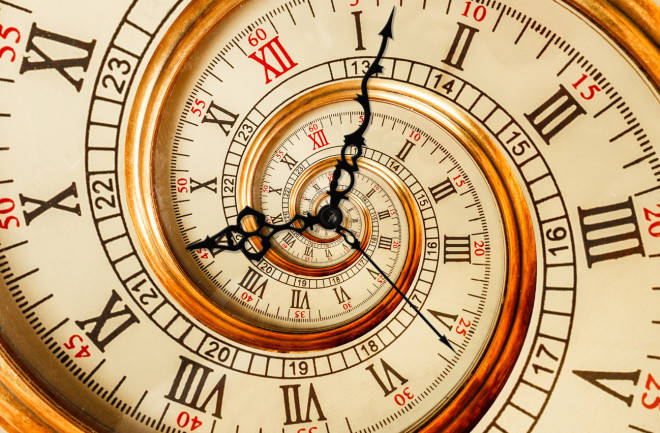
Yes, Einstein wrote something along the lines of “time is an illusion.” But it’s not altogether clear what Einstein meant — and to understand what he might have been saying, we must dig into the circumstances that caused him to write it.
A Stubbornly Persistent Illusion
A close friend of Einstein’s, Michele Besso, passed away in 1955. Only a month before his own death, Einstein wrote to Besso’s grieving family.
His letter said, “Now he has departed from this strange world a little ahead of me. That signifies nothing. For those of us who believe in physics, the distinction between past, present and future is only a stubbornly persistent illusion."
Obviously, at the time of his writing Einstein had some profound thoughts about the nature of time.
Unfortunately for us, he did not further explain his thoughts in this letter; nor did he ever indicate in any of his previous work that he thought of the distinction between past, present and future (which is generally what we refer to as time ) as an illusion.
Some physicists and philosophers have taken the statement at face value. Indeed, Einstein was not the first person to wonder if time is an illusion — and his own theory of special relativity may make the statement plausible.
Read More: Will Time Ever Stop?
Einstein’s Theory of Special Relativity
One of the key aspects of relativity, for example, is that observers are never guaranteed to agree on what now is. This stands in stark contrast to the physics of Newton, and even everyday intuition.
Because we synchronize our clocks around the world, it’s easy to assume that this synchronicity extends throughout the universe. If you snap your fingers, then everyone throughout the universe should be able to agree on the instant that you snapped your fingers, right?
But relativity makes this false.
Different observers, depending on their speed, will disagree on what now is. And the fact that signals must travel no faster than the speed of light means that now only applies to observers close to one another.
If you snap your fingers, therefore, an astronaut on Mars won’t find out for about 3 minutes. Now means something different to Martians than it does to you.
What Is the Relativity of Simultaneity?
But as wonky as the concept of now becomes in relativity, some things — like causality — are preserved. All observers traveling slower or at the speed of light will always agree on the sequence of events, even if they disagree about the duration of time between those events.
So, even in relativity, causes always lead to effects. And the past always takes place before the present, which always takes place before the future. We won’t always agree on how quick that rate of progression is, but we’ll always agree on the order.
This “relativity of simultaneity” allows physicists to expand upon a philosophical notion.
Humans have an intuitive sense that the past already exists and is locked in place, inaccessible to us except through our memories, while we continually experience the present. Meanwhile, the future is also inaccessible and unknowable to us, until we get there and it becomes the present.
But perhaps that experience of time is just that — an experience. Perhaps the future is just as locked in place as the past, and we simply can’t access it for some psychological reason. Perhaps our consciousness demands a “flow” from past to present to future, when in reality there is no such strict direction.
Read More: Why Can’t We Reverse the Arrow of Time?
What Is the Block Universe?
This concept, where all events that have occurred and have yet to occur already exist, is known as the block universe.
In it, all dimensions — the three of space and the one of time — exist as a single unit; we travel down the line of time, experiencing a flow to events that is not really there, creating a story from a sequence of events that was always going to happen anyway.
Perhaps this is what Einstein had in mind when he wrote a letter to his friend’s heartbroken family. From this viewpoint, the distinction between past and future is as arbitrary and simple as the distinction between up and down or left and right.
But even Einstein himself reflexively referred to time in his letter: “ Now he has departed … ahead of me.”
Einstein may have believed in something like the block universe, but even the block universe doesn’t abolish time itself or call it an illusion. Instead, it calls into question our subjective experience of the flow of time, something that is definitely up for philosophical debate.
For now, of course.
Read More: How Does Multiverse Theory Relate to Time Travel?
Already a subscriber?
Register or Log In

Keep reading for as low as $1.99!
Sign up for our weekly science updates.
Save up to 40% off the cover price when you subscribe to Discover magazine.
Einstein's Theory of Special Relativity
Special relativity: It's like normal relativity, but special.
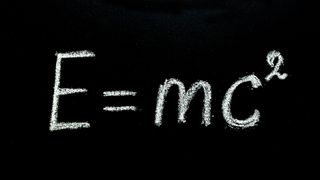
What was physics like before relativity?
How did einstein come up with special relativity, what does e = mc^2 mean, time dilation, special relativity and quantum mechanics, additional resources.
Albert Einstein 's 1905 theory of special relativity is one of the most important papers ever published in the field of physics. Special relativity is an explanation of how speed affects mass, time and space. The theory includes a way for the speed of light to define the relationship between energy and matter — small amounts of mass (m) can be interchangeable with enormous amounts of energy (E), as defined by the classic equation E = mc^2.
Special relativity applies to "special" cases — it's mostly used when discussing huge energies, ultra-fast speeds and astronomical distances, all without the complications of gravity . Einstein officially added gravity to his theories in 1915, with the publication of his paper on general relativity .
As an object approaches the speed of light, the object's mass becomes infinite and so does the energy required to move it. That means it is impossible for any matter to go faster than light travels. This cosmic speed limit inspires new realms of physics and science fiction, as people consider travel across vast distances.
Before Einstein, astronomers (for the most part) understood the universe in terms of three laws of motion presented by Isaac Newton in 1686. These three laws are:
- Objects in motion or at rest remain in the same state unless an external force imposes change. This is also known as the concept of inertia .
- The force acting on an object is equal to the mass of the object multiplied by its acceleration. In other words, you can calculate how much force it takes to move objects with various masses at different speeds.
- For every action, there is an equal and opposite reaction .
Newton's laws proved valid in nearly every application in physics, according to Encyclopedia Britannica . They formed the basis for our understanding of mechanics and gravity.
But some things couldn't be explained by Newton's work: For example, light.
To shoehorn the odd behavior of light into Newton's framework for physics scientists in the 1800s supposed that light must be transmitted through some medium, which they called the "luminiferous ether." That hypothetical ether had to be rigid enough to transfer light waves like a guitar string vibrates with sound, but also completely undetectable in the movements of planets and stars.
That was a tall order. Researchers set about trying to detect that mysterious ether, hoping to understand it better. In 1887, wrote astrophysicist Ethan Siegal in the Forbes science blog, Starts With a Bang , physicist Albert A. Michelson and chemist Edward Morley calculated how Earth's motion through the ether affected how the speed of light is measured, and unexpectedly found that the speed of light is the same no matter what Earth's motion is.
If the speed of light didn't change despite the Earth's movement through the ether, they concluded, there must be no such thing as ether to begin with: Light in space moved through a vacuum.
That meant it couldn't be explained by classical mechanics. Physics needed a new paradigm.
According to Einstein, in his 1949 book " Autobiographical Notes " (Open Court, 1999, Centennial Edition), the budding physicist began questioning the behavior of light when he was just 16 years old. In a thought experiment as a teenager, he wrote, he imagined chasing a beam of light.
Classical physics would imply that as the imaginary Einstein sped up to catch the light, the light wave would eventually come to a relative speed of zero — the man and the light would be moving at speed together, and he could see light as a frozen electromagnetic field. But, Einstein wrote, this contradicted work by another scientist, James Clerk Maxwell, whose equations required that electromagnetic waves always move at the same speed in a vacuum: 186,282 miles per second (300,000 kilometers per second).
Philosopher of physics John D. Norton challenged Einstein's story in his book " Einstein for Everyone " (Nullarbor Press, 2007), in part because as a 16-year-old, Einstein wouldn't yet have encountered Maxwell's equations. But because it appeared in Einstein's own memoir, the anecdote is still widely accepted.
If a person could, theoretically, catch up to a beam of light and see it frozen relative to their own motion, would physics as a whole have to change depending on a person's speed, and their vantage point? Instead, Einstein recounted, he sought a unified theory that would make the rules of physics the same for everyone, everywhere, all the time.
This, wrote the physicist, led to his eventual musings on the theory of special relativity, which he broke down into another thought experiment: A person is standing next to a train track comparing observations of a lightning storm with a person inside the train. And because this is physics, of course, the train is moving nearly the speed of light.
Einstein imagined the train at a point on the track equally between two trees. If a bolt of lightning hit both trees at the same time, the person beside the track would see simultaneous strikes. But because they are moving toward one lightning bolt and away from the other, the person on the train would see the bolt ahead of the train first, and the bolt behind the train later.
Einstein concluded that simultaneity is not absolute, or in other words, that simultaneous events as seen by one observer could occur at different times from the perspective of another. It's not lightspeed that changes, he realized, but time itself that is relative. Time moves differently for objects in motion than for objects at rest. Meanwhile, the speed of light, as observed by anyone anywhere in the universe, moving or not moving, is always the same.
One of the most famous and well-known equations in all of human history, E = mc^2, translates to "energy is equal to mass times the speed of light squared." In other words, wrote PBS Nova , energy (E) and mass (m) are interchangeable. They are, in fact, just different forms of the same thing.
But they're not easily exchanged. Because the speed of light is already an enormous number, and the equation demands that it be multiplied by itself (or squared) to become even larger, a small amount of mass contains a huge amount of energy. For example, PBS Nova explained, "If you could turn every one of the atoms in a paper clip into pure energy — leaving no mass whatsoever — the paper clip would yield [the equivalent energy of] 18 kilotons of TNT. That's roughly the size of the bomb that destroyed Hiroshima in 1945."
One of the many implications of Einstein's special relativity work is that time moves relative to the observer. An object in motion experiences time dilation, meaning that when an object is moving very fast it experiences time more slowly than when it is at rest.
For example, when astronaut Scott Kelly spent nearly a year aboard the International Space Station starting in 2015, he was moving much faster than his twin brother, astronaut Mark Kelly, who spent the year on the planet's surface. Due to time dilation, Mark Kelly aged just a little faster than Scott — "five milliseconds," according to the earth-bound twin. Since Scott wasn't moving near lightspeed, the actual difference in aging due to time dilation was negligible. In fact, considering how much stress and radiation the airborne twin experienced aboard the ISS, some would argue Scott Kelly increased his rate of aging.
But at speeds approaching the speed of light, the effects of time dilation could be much more apparent. Imagine a 15-year-old leaves her high school traveling at 99.5% of the speed of light for five years (from the teenage astronaut's perspective). When the 15-year-old got back to Earth, she would have aged those 5 years she spent traveling. Her classmates, however, would be 65 years old — 50 years would have passed on the much slower-moving planet.
We don't currently have the technology to travel anywhere near that speed. But with the precision of modern technology, time dilation does actually affect human engineering.
GPS devices work by calculating a position based on communication with at least three satellites in distant Earth orbits. Those satellites have to keep track of incredibly precise time in order to pinpoint a location on the planet, so they work based on atomic clocks. But because those atomic clocks are on board satellites that are constantly whizzing through space at 8,700 mph (14,000 km/h), special relativity means that they tick an extra 7 microseconds, or 7 millionths of a second, each day, according to American Physical Society publication Physics Central . In order to maintain pace with Earth clocks, atomic clocks on GPS satellites need to subtract 7 microseconds each day.
With additional effects from general relativity (Einstein's follow-up to special relativity that incorporates gravity), clocks closer to the center of a large gravitational mass like Earth tick more slowly than those farther away. That effect adds microseconds to each day on a GPS atomic clock, so in the end engineers subtract 7 microseconds and add 45 more back on. GPS clocks don't tick over to the next day until they have run a total of 38 microseconds longer than comparable clocks on Earth.
Special relativity and quantum mechanics are two of the most widely accepted models of how our universe works. But special relativity mostly pertains to extremely large distances, speeds and objects, uniting them in a "smooth" model of the universe. Events in special (and general) relativity are continuous and deterministic, wrote Corey Powell for The Guardian , which means that every action results in a direct, specific and local consequence. That's different from quantum mechanics, Powell continued: quantum physics are "chunky," with events occurring in jumps or "quantum leaps" that have probabilistic outcomes, not definite ones.
Researchers uniting special relativity and quantum mechanics — the smooth and the chunky, the very large and the very small — have come up with fields like relativistic quantum mechanics and, more recently, quantum field theory to better understand subatomic particles and their interactions.
Researchers striving to connect quantum mechanics and general relativity, on the other hand, consider it to be one of the great unsolved problems in physics. For decades, many viewed string theory to be the most promising area of research into a unified theory of all physics. Now, a host of additional theories exist. For example, one group proposes space-time loops to link the tiny, chunky quantum world with the wide relativistic universe.
- Check out this time dilation calculator from Omni Calculator .
- Explore Einstein's thought experiments in this video from PBS Nova .
- Go back to the source and read Einstein's explainer in this translated edition of his book, Relativity: The Special and General Theory (Dover, 2001).
This article was originally written by Elizabeth Howell and has since been updated.
Join our Space Forums to keep talking space on the latest missions, night sky and more! And if you have a news tip, correction or comment, let us know at: [email protected].
Get the Space.com Newsletter
Breaking space news, the latest updates on rocket launches, skywatching events and more!
Vicky Stein is a science writer based in California. She has a bachelor's degree in ecology and evolutionary biology from Dartmouth College and a graduate certificate in science writing from the University of California, Santa Cruz (2018). Afterwards, she worked as a news assistant for PBS NewsHour, and now works as a freelancer covering anything from asteroids to zebras. Follow her most recent work (and most recent pictures of nudibranchs) on Twitter.
Just how dark is the universe? NASA's New Horizons probe gives us best estimate yet
UAE on track to launch bold 7-asteroid mission in 2028
NASA's Voyager 1 probe swaps thrusters in tricky fix as it flies through interstellar space
Most Popular
- 2 New record! 19 people are orbiting Earth right now
- 3 How SpaceX built a new spacesuit for Polaris Dawn's private spacewalk (video)
- 4 Meet the NASA science flying on SpaceX's Polaris Dawn private astronaut mission
- 5 Lego is 'Over the Moon' with new spaceship kit made in collaboration with Pharrell Williams
Scientists Explain Why Time Travel Is Possible
March 6 -- In H.G. Wells' 1895 novel, The Time Machine, a radical scientist, weary from his travels to the future and back, warns his colleagues that his story will be difficult to believe.
"I don't mind telling you the story," the Time Traveler says to his friends. "But I can't argue … Most of it will sound like lying. So be it!"
The Time Traveler's story may have sounded outrageous to his colleagues, but today physicists think Wells was onto something. In fact, according to Albert Einstein's famous equation, E = mc ² , time travel is possible, at least in one direction. Going the other way — back to the past — presents a trickier challenge.
All About Einstein
This Friday, the stories of the Time Traveler, updated to suit a 21st century world, will once again be presented in a Dream Works and Warner Bros. Picture film, starring Guy Pearce. And, once again, the concept of time travel will seem far-fetched and improbable.
But physicists warn just because the feat may seem impossible, doesn't mean it is.
"We have a hard time perceiving how time can bend just like other dimensions, so Einstein's predictions seem strange," said J. Richard Gott, author of the book Time Travel in Einstein's Universe and a professor of astrophysics at Princeton University. "But this appears to be the world we live in."
Part of the "strange" world that Einstein explained in 1905 in his theory of relativity is that time and space are joined in our universe as a four-dimensional fabric known as space-time. Stranger yet is the concept that both space and time warp as mass or speed is increased.
Travel fast and time moves more slowly. Increase the mass around you to near collapsible levels and you get the same effect.
The phenomenon has already been proven, albeit at minute scales.
Slowed Clocks, Younger Particles
In 1975 Carol Allie of the University of Maryland synchronized two atomic clocks and placed one on a plane and flew it around for several hours and left the other on Earth. When the airborne clock was returned to Earth, she compared its time with the one that hadn't moved and found that time had moved a fraction of a second more slowly for the clock on board the plane.
Popular Reads

How to watch the Harris-Trump ABC News debate
- Sep 10, 8:55 PM

Fact-checking Harris and Trump presidential debate
- Sep 11, 7:08 AM

Suspect at large in freeway shooting
- Sep 8, 11:18 PM
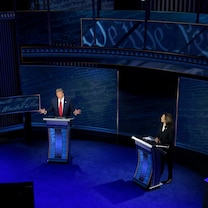
Key takeaways from Harris-Trump ABC News debate
- Sep 11, 12:19 AM

4 dead in shooting at Georgia high school
- Sep 4, 10:47 PM
ABC News Live
24/7 coverage of breaking news and live events
October 24, 2014
11 min read
Time’s Passage is Probably an Illusion
From the fixed past to the tangible present to the undecided future, it feels as though time flows inexorably on. But that is an illusion
By Paul Davies

To be perfectly honest, neither scientists nor philosophers really know what time is or why it exists. The best thing they can say is that time is an extra dimension akin (but not identical) to space. For example, the two-dimensional orbit of the moon through space can be thought of as a three-dimensional corkscrew through spacetime.
Bryan Christie Design
Gather ye rosebuds while ye may,/old time is still a-flying.” So wrote 17th-century English poet Robert Herrick, capturing the universal cliché that time flies. And who could doubt that it does? The passage of time is probably the most basic facet of human perception, for we feel time slipping by in our innermost selves in a manner that is altogether more intimate than our experience of, say, space or mass. The passage of time has been compared to the flight of an arrow and to an ever rolling stream, bearing us inexorably from past to future. Shakespeare wrote of “the whirligig of time,” his countryman Andrew Marvell of “Time's winged chariot hurrying near.”
Evocative though these images may be, they run afoul of a deep and devastating paradox. Nothing in known physics corresponds to the passage of time. Indeed, physicists insist that time doesn't flow at all; it merely is. Some philosophers argue that the very notion of the passage of time is nonsensical and that talk of the river or flux of time is founded on a misconception. How can something so basic to our experience of the physical world turn out to be a case of mistaken identity? Or is there a key quality of time that science has not yet identified?
Time Isn't of the Essence
On supporting science journalism.
If you're enjoying this article, consider supporting our award-winning journalism by subscribing . By purchasing a subscription you are helping to ensure the future of impactful stories about the discoveries and ideas shaping our world today.
In daily life we divide time into three parts: past, present and future. The grammatical structure of language revolves around this fundamental distinction. Reality is associated with the present moment. The past we think of as having slipped out of existence, whereas the future is even more shadowy, its details still unformed. In this simple picture, the “now” of our conscious awareness glides steadily onward, transforming events that were once in the unformed future into the concrete but fleeting reality of the present—and thence relegating them to the fixed past.
Obvious though this commonsense description may seem, it is seriously at odds with modern physics. Albert Einstein famously expressed this point when he wrote to a friend, “The past, present and future are only illusions, even if stubborn ones.” Einstein's startling conclusion stems directly from his special theory of relativity, which denies any absolute, universal significance to the present moment. According to the theory, simultaneity is relative. Two events that occur at the same moment if observed from one reference frame may occur at different moments if viewed from another.
An innocuous question such as “What is happening on Mars now?” has no definite answer. The key point is that Earth and Mars are a long way apart—up to about 20 light-minutes. Because information cannot travel faster than light, an Earth-based observer is unable to know the situation on Mars at the same instant. He must infer the answer after the event, when light has had a chance to pass between the planets. The inferred past event will be different depending on the observer's velocity.
For example, during a future manned expedition to Mars, mission controllers back on Earth might say, “I wonder what Commander Jones is doing at Alpha Base now.” Looking at their clock and seeing that it was 12:00 P.M. on Mars, their answer might be “eating lunch.” But an astronaut zooming past Earth at near the speed of light at the same moment could, on looking at his clock, say that the time on Mars was earlier or later than 12:00 P.M., depending on his direction of motion. That astronaut's answer to the question about Commander Jones's activities would be “cooking lunch” or “washing dishes” [see "It's All Relative" graphic, below]. Such mismatches make a mockery of any attempt to confer special status on the present moment, for whose “now” does that moment refer to? If you and I were in relative motion, an event that I might judge to be in the as yet undecided future might for you already exist in the fixed past.
The most straightforward conclusion is that both past and future are fixed. For this reason, physicists prefer to think of time as laid out in its entirety—a timescape, analogous to a landscape—with all past and future events located there together. It is a notion sometimes referred to as block time. Completely absent from this description of nature is anything that singles out a privileged, special moment as the present or any process that would systematically turn future events into present, then past, events. In short, the time of the physicist does not pass or flow.
How Time Doesn't Fly
A number of philosophers over the years have arrived at the same conclusion by examining what we normally mean by the passage of time. They argue that the notion is internally inconsistent. The concept of flux, after all, refers to motion. It makes sense to talk about the movement of a physical object, such as an arrow through space, by gauging how its location varies with time. But what meaning can be attached to the movement of time itself? Relative to what does it move? Whereas other types of motion relate one physical process to another, the putative flow of time relates time to itself. Posing the simple question “How fast does time pass?” exposes the absurdity of the very idea. The trivial answer “one second per second” tells us nothing at all.
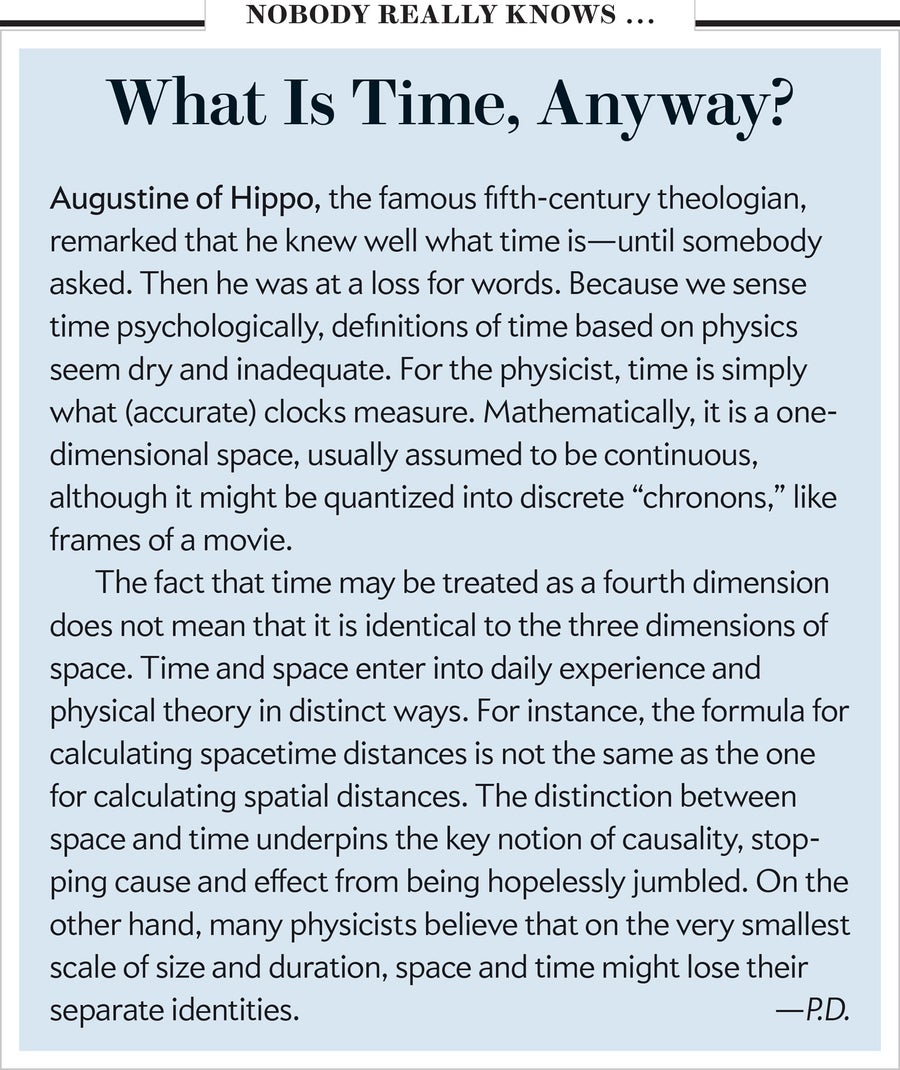
Credit : Bryan Christie Design
Although we find it convenient to refer to time's passage in everyday affairs, the notion imparts no new information that cannot be conveyed without it. Consider the following scenario: Alice was hoping for a white Christmas, but when the day came she was disappointed that it only rained; however, she was happy that it snowed the following day. Although this description is replete with tenses and references to time's passage, exactly the same information is conveyed by simply correlating Alice's mental states with dates, in a manner that omits all reference to time passing or the world changing. Thus, the following cumbersome and rather dry catalogue of facts suffices:
December 24: Alice hopes for a white Christmas.
December 25: There is rain. Alice is disappointed.
December 26: There is snow. Alice is happy.
In this description, nothing happens or changes. There are simply states of the world at different dates and associated mental states for Alice.
Similar arguments go back to ancient Greek philosophers such as Parmenides and Zeno. A century ago British philosopher John McTaggart sought to draw a clear distinction between the description of the world in terms of events happening, which he called the A series, and the description in terms of dates correlated with states of the world, the B series. Each appears to be a true description of reality, and yet the two points of view are seemingly in contradiction. For example, the event “Alice is disappointed” was once in the future, then in the present and afterward in the past. But past, present and future are exclusive categories, so how can a single event have the character of belonging to all three? McTaggart used this clash between the A and B series to argue for the unreality of time as such, perhaps a rather drastic conclusion. Most physicists would put it less dramatically: the flow of time is unreal, but time itself is as real as space.
Just in Time
A great source of confusion in discussions of time's passage stems from its link with the so-called arrow of time. To deny that time flows is not to claim that the designations “past” and “future” are without physical basis. Events in the world undeniably form a unidirectional sequence. For instance, an egg dropped on the floor will smash into pieces, whereas the reverse process—a broken egg spontaneously assembling itself into an intact egg—is never witnessed. This is an example of the second law of thermodynamics, which states that the entropy of a closed system—roughly defined as how disordered it is—will tend to rise with time. An intact egg has lower entropy than a shattered one.
Because nature abounds with irreversible physical processes, the second law of thermodynamics plays a key role in imprinting on the world a conspicuous asymmetry between past and future directions along the time axis. By convention, the arrow of time points toward the future. This does not imply, however, that the arrow is moving toward the future, any more than a compass needle pointing north indicates that the compass is traveling north. Both arrows symbolize an asymmetry, not a movement. The arrow of time denotes an asymmetry of the world in time, not an asymmetry or flux of time. The labels “past” and “future” may legitimately be applied to temporal directions, just as “up” and “down” may be applied to spatial directions, but talk of the past or the future is as meaningless as referring to the up or the down.
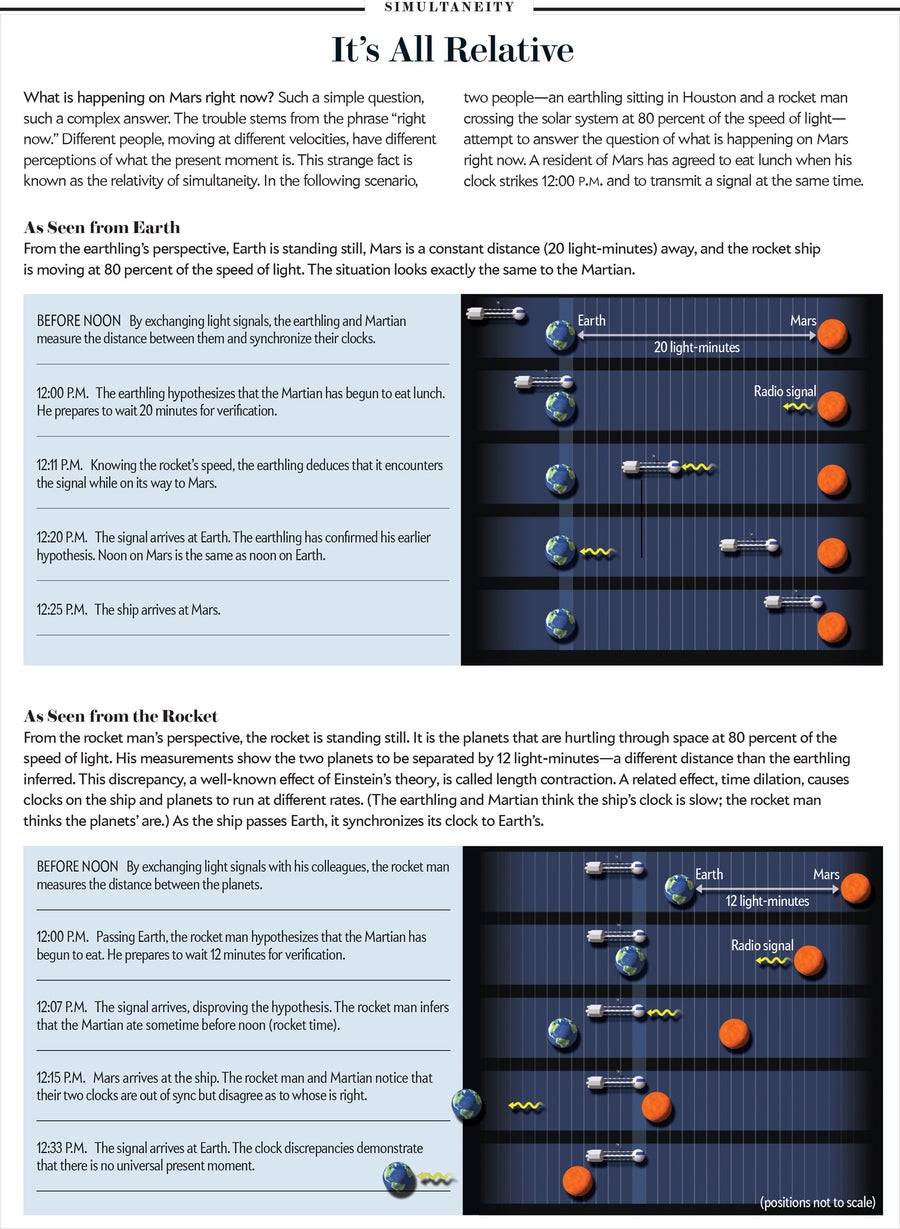
The distinction between pastness or futureness and “the” past or “the” future is graphically illustrated by imagining a movie of, say, the egg being dropped on the floor and breaking. If the film were run backward through the projector, everyone would see that the sequence was unreal. Now imagine if the film strip were cut up into frames and the frames shuffled randomly. It would be a straightforward task for someone to rearrange the stack of frames into a correctly ordered sequence, with the broken egg at the top of the stack and the intact egg at the bottom. This vertical stack retains the asymmetry implied by the arrow of time because it forms an ordered sequence in vertical space, proving that time's asymmetry is actually a property of states of the world, not a property of time as such. It is not necessary for the film to actually be run as a movie for the arrow of time to be discerned.
Given that most physical and philosophical analyses of time fail to uncover any sign of a temporal flow, we are left with something of a mystery. To what should we attribute the powerful, universal impression that the world is in a continual state of flux? Some researchers, notably the late Nobel laureate chemist Ilya Prigogine, have contended that the subtle physics of irreversible processes make the flow of time an objective aspect of the world. But I and others argue that it is some sort of illusion.
After all, we do not really observe the passage of time. What we actually observe is that later states of the world differ from earlier states that we still remember. The fact that we remember the past, rather than the future, is an observation not of the passage of time but of the asymmetry of time. Nothing other than a conscious observer registers the flow of time. A clock measures durations between events much as a measuring tape measures distances between places; it does not measure the “speed” with which one moment succeeds another. Therefore, it appears that the flow of time is subjective, not objective.

Living in the Present
This illusion cries out for explanation, and that explanation is to be sought in psychology, neurophysiology, and maybe linguistics or culture. Modern science has barely begun to consider the question of how we perceive the passage of time; we can only speculate about the answer. It might have something to do with the functioning of the brain. If you spin around several times and stop suddenly, you will feel giddy. Subjectively, it seems as if the world is rotating relative to you, but the evidence of your eyes is clear enough: it is not. The apparent movement of your surroundings is an illusion created by the rotation of fluid in the inner ear. Perhaps temporal flux is similar.
There are two aspects to time asymmetry that might create the false impression that time is flowing. The first is the thermodynamic distinction between past and future. As physicists have realized over the past few decades, the concept of entropy is closely related to the information content of a system. For this reason, the formation of memory is a unidirectional process—new memories add information and raise the entropy of the brain. We might perceive this unidirectionality as the flow of time.
A second possibility is that our perception of the flow of time is linked in some way to quantum mechanics. It was appreciated from the earliest days of the formulation of quantum mechanics that time enters into the theory in a unique manner, quite unlike space. The special role of time is one reason it is proving so difficult to merge quantum mechanics with general relativity. The Heisenberg uncertainty principle, according to which nature is inherently indeterministic, implies an open future (and, for that matter, an open past). This indeterminism manifests itself most conspicuously on an atomic scale of size and dictates that the observable properties that characterize a physical system are generally undecided from one moment to the next.
For example, an electron hitting an atom may bounce off in one of many directions, and it is normally impossible to predict in advance what the outcome in any given case will be. Quantum indeterminism implies that for a particular quantum state there are many (possibly infinite) alternative futures or potential realities. Quantum mechanics supplies the relative probabilities for each observable outcome, although it won't say which potential future is destined for reality.
But when a human observer makes a measurement, one and only one result is obtained; for example, the rebounding electron will be found moving in a certain direction. In the act of measurement, a single, specific reality gets projected out from a vast array of possibilities. Within the observer's mind, the possible makes a transition to the actual, the open future to the fixed past—which is precisely what we mean by the flux of time.
There is no agreement among physicists on how this transition from many potential realities into a single actuality takes place. Many physicists have argued that it has something to do with the consciousness of the observer, on the basis that it is the act of observation that prompts nature to make up its mind. A few researchers, such as Roger Penrose of the University of Oxford, maintain that consciousness—including the impression of temporal flux—could be related to quantum processes that take place in the brain.
Although researchers have failed to find evidence for a single “time organ” in the brain, in the manner of, say, the visual cortex, it may be that future work will pin down those brain processes responsible for our sense of temporal passage. It is possible to imagine drugs that could suspend the subject's impression that time is passing. Indeed, some practitioners of meditation claim to be able to achieve such mental states naturally.
And what if science were able to explain away the flow of time? Perhaps we would no longer fret about the future or grieve for the past. Worries about death might become as irrelevant as worries about birth. Expectation and nostalgia might cease to be part of human vocabulary. Above all, the sense of urgency that attaches to so much of human activity might evaporate. No longer would we be slaves to Henry Wadsworth Longfellow's entreaty to “act, act in the living present,” for the past, present and future would literally be things of the past.
Paul Davies is Regents' Professor at Arizona State University, director of the Beyond Center for Fundamental Concepts in Science and co-director of the Arizona State University Cosmology Initiative .
Want a daily email of lesson plans that span all subjects and age groups?
Is time travel possible - colin stuart.
3,863,766 Views
15,332 Questions Answered
Let’s Begin…
Time travel is a staple of science fiction stories, but is it actually possible? It turns out nature does allow a way of bending time, an exciting possibility suggested by Albert Einstein when he discovered special relativity over one hundred years ago. Colin Stuart imagines where (or, when) this fascinating phenomenon, time dilation, may one day take us.
About TED-Ed Animations
TED-Ed Animations feature the words and ideas of educators brought to life by professional animators. Are you an educator or animator interested in creating a TED-Ed Animation? Nominate yourself here »
Meet The Creators
- Educator Colin Stuart
- Director Franz Palomares
- Animation Artist Godfrey Hibbert
- Narrator Colin Stuart
Stephen Hawking’s final book suggests time travel may one day be possible – here’s what to make of it
Research Fellow in the Particle Cosmology Group, School of Physics and Astronomy, University of Nottingham
Disclosure statement
Peter Millington receives funding from the Leverhulme Trust.
University of Nottingham provides funding as a founding partner of The Conversation UK.
View all partners
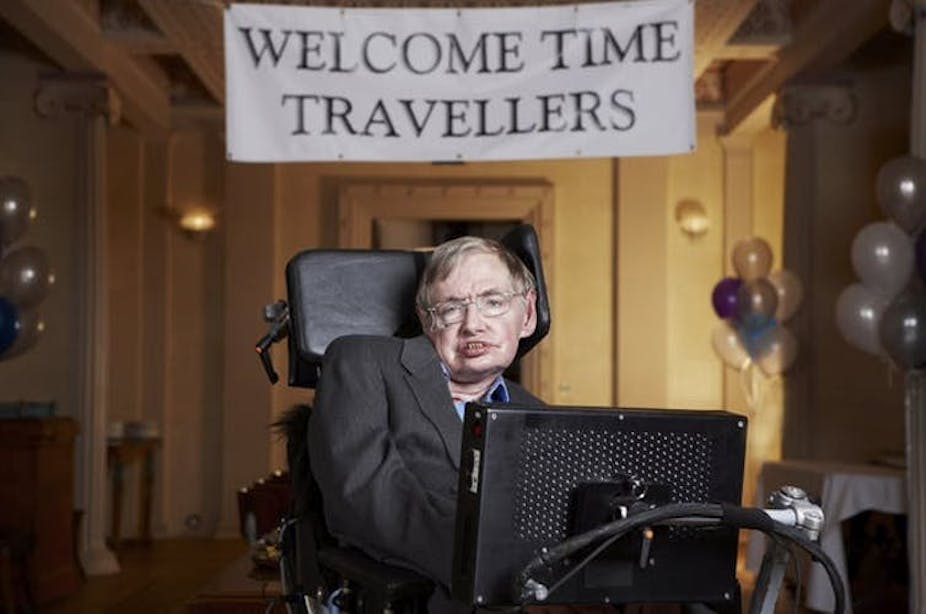
“If one made a research grant application to work on time travel it would be dismissed immediately,” writes the physicist Stephen Hawking in his posthumous book Brief Answers to the Big Questions . He was right. But he was also right that asking whether time travel is possible is a “very serious question” that can still be approached scientifically.
Arguing that our current understanding cannot rule it out, Hawking, it seems, was cautiously optimistic. So where does this leave us? We cannot build a time machine today, but could we in the future?
Let’s start with our everyday experience. We take for granted the ability to call our friends and family wherever they are in the world to find out what they are up to right now . But this is something we can never actually know. The signals carrying their voices and images travel incomprehensibly fast, but it still takes a finite time for those signals to reach us.
Our inability to access the “now” of someone far away is at the heart of Albert Einstein’s theories of space and time .
Light speed
Einstein told us that space and time are parts of one thing – spacetime – and that we should be as willing to think about distances in time as we are distances in space. As odd as this might sound, we happily answer “about two and half hours”, when someone asks how far Birmingham is from London. What we mean is that the journey takes that long at an average speed of 50 miles per hour.
Mathematically, our statement is equivalent to saying that Birmingham is about 125 miles from London. As physicists Brian Cox and Jeff Forshaw write in their book Why does E=mc²? , time and distance “can be interchanged using something that has the currency of a speed”. Einstein’s intellectual leap was to suppose that the exchange rate from a time to a distance in spacetime is universal – and it is the speed of light.
The speed of light is the fastest any signal can travel, putting a fundamental limit on how soon we can know what is going on elsewhere in the universe. This gives us “causality” – the law that effects must always come after their causes. It is a serious theoretical thorn in the side of time-travelling protagonists. For me to travel back in time and set in motion events that prevent my birth is to put the effect (me) before the cause (my birth).
Now, if the speed of light is universal (in the vacuum of empty space), we must measure it to be the same – 299,792,458 metres per second – however fast we ourselves are moving. Einstein realised that the consequence of the speed of light being absolute is that space and time itself cannot be. And it turns out that moving clocks must tick slower than stationary ones.
If I were to fly off at incredible speed in a spaceship and return to Earth , less time would pass for me than it would for everyone I left behind. Everyone I returned to would conclude that my life had run as if in slow motion – I would have aged more slowly than them – and I would conclude that theirs had run as if in fast forward. The faster I travelled, the slower my clock would tick relative to clocks on Earth. And if I made the trip at the speed of light, I would return as if I had been frozen in time.
So what if we were to travel faster than light, would time run backwards as science fiction has taught us?
Unfortunately, it takes infinite energy to accelerate a human being to the speed of light, let alone beyond it. But even if we could , time wouldn’t simply run backwards. Instead, it would no longer make sense to talk about forward and backward at all. The law of causality would be violated and the concept of cause and effect would lose its meaning.
Einstein also told us that the force of gravity is a consequence of the way mass warps space and time . The more mass we squeeze into a region of space, the more spacetime is warped and the slower nearby clocks tick. If we squeeze in enough mass, spacetime becomes so warped that even light cannot escape its gravitational pull and a black hole is formed. And if you were to approach the edge of the black hole – its event horizon – your clock would tick infinitely slowly relative to those far away from it.
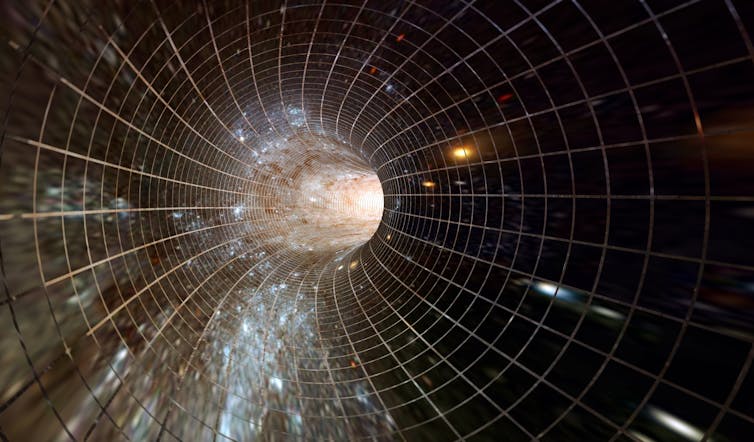
So could we warp spacetime in just the right way to close it back on itself and travel back in time?
The answer is maybe, and the warping we need is a traversable wormhole . But we also need to produce regions of negative energy density to stabilise it, and the classical physics of the 19th century prevents this. The modern theory of quantum mechanics , however, might not.
According to quantum mechanics, empty space is not empty. Instead, it is filled with pairs of particles that pop in and out of existence. If we can make a region where fewer pairs are allowed to pop in and out than everywhere else, then this region will have negative energy density.
However, finding a consistent theory that combines quantum mechanics with Einstein’s theory of gravity remains one of the biggest challenges in theoretical physics. One candidate, string theory (more precisely M-theory ) may offer up another possibility.
M-theory requires spacetime to have 11 dimensions: the one of time and three of space that we move in and seven more, curled up invisibly small. Could we use these extra spatial dimensions to shortcut space and time? Hawking, at least, was hopeful.
Saving history
So is time travel really a possibility? Our current understanding can’t rule it out, but the answer is probably no.
Einstein’s theories fail to describe the structure of spacetime at incredibly small scales. And while the laws of nature can often be completely at odds with our everyday experience, they are always self-consistent – leaving little room for the paradoxes that abound when we mess with cause and effect in science fiction’s take on time travel.
Despite his playful optimism, Hawking recognised that the undiscovered laws of physics that will one day supersede Einstein’s may conspire to prevent large objects like you and I from hopping casually (not causally) back and forth through time. We call this legacy his “ chronology protection conjecture ”.
Whether or not the future has time machines in store, we can comfort ourselves with the knowledge that when we climb a mountain or speed along in our cars, we change how time ticks.
So, this “ pretend to be a time traveller day ” (December 8), remember that you already are, just not in the way you might hope.
- Time travel
- Stephen Hawking

Indigenous Graduate Research Program Coordinator

Director of STEM

Community member - Training Delivery and Development Committee (Volunteer part-time)

Chief Executive Officer

Head of Evidence to Action
Your Time Travel Experience
Books, movies and articles about time travel
- More Movies
- Books And Stories
- More Legends
- The Time Travel Store
Science Theories
- Video Library
- About Cristina
- Privacy Policy
- GDRP Requirements
Einstein and Time Travel – His Theories
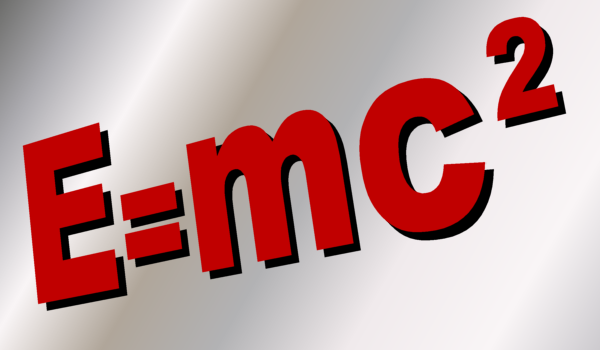
Cristina Boros April 17, 2016 16 Comments
Einstein and time travel , Einstein theories , theory of relativity
Welcome, and I am very happy to have you here again today 🙂 and talk to you about Albert Einstein and time travel.
Let’s have a look at the scientific part of this subject of time travel. Do you think time travel is just fiction found in movies, books, and games, or could it be a future reality?
We have had some great minds of the century some offered theories, one of them being by the physicist Albert Einstein. So, talking about Einstein and time travel let’s try to understand his theories.
I know it is not a very simple subject but I also think many of you would like to know his ideas, so I will try to explain them as clearly and as simple as I can.
I am not a physicist myself so let’s see in simple terms what Einstein proved with his theories.
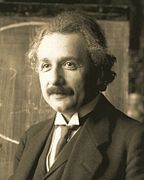
The Theory of Special Relativity
First of all, Einstein proved that time is relative; a very different opinion from Newton who claimed that time is absolute. But which one was right? How did Einstein sustain his theory?
His theory says that when you move through space-time at the speed of light, time goes slower for you than for the others.
For example
Travelling with a very fast spaceship, one person would get older by only a few days whereas another who is on the earth, by month or years.
It is said that the faster we travel, the slower time passes.
In 1905, Einstein explained in this theory time-space as a fourth dimension.
To prove this theory, in 1975 Carol Allie made an experiment at the University of Maryland.
Two clocks were synchronized and one was placed on an airplane and another in the laboratory.
When the clock that was placed on the aircraft returned after a few hours of flight, it was seen to be a fraction of a second faster than the clock that remained in the laboratory.
Ok, this is an experiment on a small scale, but what if the clock was placed on a spaceship that flew at the speed of light?
Einstein claims that for a time travel journey to be successful, you would need to be able to travel at the speed of light.
So according to his theory, Einstein claims that traveling at a speed close to the speed of light will slow the time, reaching the speed of light will stop time and if it will be ever possible to pass the speed of light, time will reverse.
General Relativity – Einstein’s Theory
Another theory of this great physicist was that time passes slower for objects in a gravitational field than for an object which is far from such a field.
So here we have black holes, where the gravity is intense.
Kip Thorne (University of California) claimed that wormholes do exist in space and that they are shortcuts to the past. If two wormholes are connected, it could make a passageway to the past or future.

His theory was confirmed in 1919 when during a solar eclipse, astronomers measured the curving of starlight around the Sun.
One more time in 1922, during another sun eclipse confirmed Einstein was right and he became famous worldwide.
Even today flights are based on his theory.
Researchers today say that they have detected gravitational waves coming from two wormholes that crashed together, located at a distance 1.3 billion light years away.
Physicists say that it is difficult to succeed in time travel because, in our world, the laws of physics are not pushed to the limit, but if we could break these rules, time travel would be possible.
Breaking the Rules
Many physicists have tried to violate Einstein’s theories or to ‘break the rules’.
Marian Scully, Lijun Wang, Gunter Nimtz, and Alfons Stalhofen are some of those names who claimed that they have succeeded in violating these theories.
The last two, at the University of Koblenz, transmitted photons at a speed faster than the speed of light, so the photons traveled into the past.
I will not write about each one because it is pure science, physics, and calculus. It would take a mind such as Einstein to understand it.
Based on Einstein theories, the novelist H.G. Wells wrote the novel ‘The time machine’ and physicists think that he was really onto something.
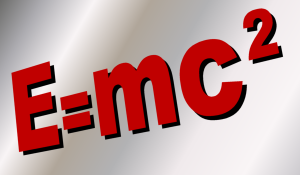
Einstein’s equation E=mc2 proves that time travel into the past is possible theoretically and scientists say that if it is still impossible for us to put this into practice, it doesn’t mean that time travel is impossible.
Stephen Hawkins says about Einstein’s theories, that to travel with a speed faster than light is almost impossible, at least in our world, and if time travel will ever be possible the past will make you stop.
The laws of physics are made not to allow us to change the past.
Now, what to think?
Reading so many different opinions I can understand just one thing. Time travel is possible but we need a more advanced technology to break the laws of physics, to use gravity and travel at the speed of light.
Does the past want to be changed?
I understand that it would be really fascinating if we could do this, but maybe this is too much?
David Lewis gives a good example of this talking about compossibility and the ability to change the past.
It is true that changing past events would have many implications, and practically it is impossible.
Lewis gives as an example
Tim, a man that hates his grandfather wants to travel into the past and kill him.
Would it be possible?
If the grandfather is killed when he is young, this would mean Tim’s parents would not exist, so Tim would also not exist to kill him.
If for example the grandfather normally dies in 1993 and Tim goes back to 1955 to kill him, would he?
Considering the present and that the grandfather should live for Tim to exist, (I will not confuse you more), Tim will be stopped from the past to succeed in killing him.
Lewis’s conclusion and exact quote is:
‘Tim doesn’t but can because he has what it takes ‘(clear shot, daylight) and also he believes that if Tim finally tries to do it, everything will stop him, a bird will fly in front of him, the gun will jam or he will just fall every time he will want to shot his grandfather.
This paradox can also be seen in many films.
So what is your conclusion?
Reading all these theories and ideas, what do you really think?
Is time travel possible only theoretically, or if we push a little bit harder on the laws of nature, can we do
I would like to know your opinion and if you have any questions just ask.
I look forward to hearing from you all and thanks for reading.
For more reading and viewing click below
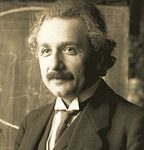
← Previous post
Next post →
16 Comments
Hi Cristina,
I just bumped into your site. That is a very informative and quite interesting article on time travelling.
So many historical personalities delved into the matter, many of them you mention in your post.
Humans are extrordinary creatures when and if they want to so I wouldn’t be surprised if that became a reality in the future.
I hope I am alive to experience it.
thanks for reading and i hope too, one time will see it real. i am the first to try :))i fell we are close
Hello Cristina, appreciate your post and very exited to read about Travel travel theories. There is nothing impossible and if the scientist put full focus on law of nature theories, we can achieve the time travel goal. However this technology should be limitedly used for example to see our earth some 5000, 10000 etc years back and future as well like year 5050. Awesome to imagine this. However all the best! Thanks
thank you for your reading and of course, if will ever be possible time travel should be used for very good reasons:)Thanks again and soon, more articles will bring the news:)
Hi, I loved all the science. I took time to view your video. It was interesting and I learned some information I didn’t know before.
Traveling in time is an intriguing idea. On the one hand I would like to see time travel become a reality. On the other hand changing time could be a problem.
One of my favorite books is The End of Eternity by Isaac Asimov. Thanks, Dave
thank you for reading. yes I think you are absolutely right if it will ever be possible time travel, i don’t think is a good idea for everyone to be able to do it .about the book i will read it and i will tell you my opinion:) thanks again
I just watched 12 monkeys and time travel is one of my favorite genres when watching TV shows and movies. I also watched a documentary of Einsten’s life and I got a gist of his theory of time-space, but still I cannot get the bending and the solar eclipse experiment. But I did enjoy the documentary. Honestly, if I could change the past, I would but my senses are telling that it is very far from reality, and may not happen in this lifetime. That is why I enjoy entertainment about it, so at least I feel contentment. How about you? How do you feel about time travel?
to be honest, I think is possible but not for everyone. It is still researched and i think that if we don’t know yet the way to do it , the ancient civilization sure did. and there are proves that there are time travelers but coming from the future . thanks for reading and I am glad that you enjoy it 🙂
Hi Cristina,I myself believe in time travel and think Einsteins theory is right on.I enjoyed your article very much, thought it was very interesting.Nice job
me too, to be honest, I believe. This is the reason i write about it and I search so many things, I am glad that you enjoyed it and stay around, 🙂 i will write more articles and I hope you will like them:)
I am seriously mind blown right now. The experiment you mentioned back in 1975 is awesome! I would like to know if they have done anymore like this recently with faster planes. I agree that we are bound by the laws of physics, but i really think that we can get over it with technology advancing more and more everyday!. I enjoyed reading this article!
i am happy that you enjoyed reading my article . i think experiments are done every year and the technology advances day by day but as soon as i know about something new… i will write about :)) i am sure in a few year you will have big surprises about faster planes . thanks 🙂
This is the most interesting article I have ever read in my life! Ok so in my opinion, I believe that time travel is possible, maybe not in our lifetime but it’s definitely possible. I mean just look at how far we’ve come over the past 15 years. Now I know that in order to travel to the past or to the future you have to travel faster than the speed of light, which is time in space.
I believe in time that we will eventually be able to live on multiple planets as technology and our resources get more and more advanced. Great article!
I also think in the future we will leave on other planets 🙂 It is also planned to colonize Mars so..it is not too far:)
Do you think not in out life time? Maybe, who knows:)
Thanks for reading and if you want to know more there are plenty of articles on my site so..have a nice time and if I can help , ask me anything:)
Interesting read! I was never 100% sure if I believed in time travel being real, but, I generally do enjoy hearing other stories and theories about that!
As far as Albert Einstein goes, I probably should learn more about him, as he seems to be one of the smartest men to live.
One thing I was not aware of was that the speed at which we travel impacts the speed at which time progresses!
His theory on going at the speed of light has me wondering, would this send one towards the future or the past? And would there be a deciding factor in terms of how far beyond or backwards in time?
I am also somewhat curious to know how he came up with this theory. Do you have an opinion on this?
Hello there:) Arie
In Einstein’s opinion based on his theories time travel can be done in the future is we travel with a speed faster than the speed of light. Not in the past.How he came up with it? He came up with this idea in 1905 , 200 years after Newton wrote about the law of motion.he publishes his theory in 1915, after ten years of studies. So hew exactly came up is a long story and I will write a post very soon stay close:)
Leave a Comment Cancel reply
Your email address will not be published. Required fields are marked *
By using this form you agree with the storage and handling of your data by this website. *

IMAGES
VIDEO
COMMENTS
Relativity means it is possible to travel into the future. We don't even need a time machine, exactly. We need to either travel at speeds close to the speed of light, or spend time in an intense ...
More than 100 years ago, a famous scientist named Albert Einstein came up with an idea about how time works. He called it relativity. This theory says that time and space are linked together. Einstein also said our universe has a speed limit: nothing can travel faster than the speed of light (186,000 miles per second).
However, Einstein's theory of time travel has been one of the most prominent and well-thought-out hypotheses about the possibility of time travel. Albert Einstein was a prominent physicist from ...
The theoretical underpinnings of time travel date back to 1905, when Albert Einstein wrote down his special theory of relativity that showed space and time are intimately linked, and to 1916, when ...
For instance, most time travel models require negative mass—and hence negative energy because, as Albert Einstein revealed when he discovered E = mc 2, mass and energy are one and the same. In ...
Einstein thanked Besso in his first paper on the Special Theory of Relativity. Article Revolution: Time Time does not progress at the same rate for everyone, everywhere. Instead, Einstein showed that how fast time progresses depends... Article Its All Relative Earth is traveling at 107,000 kilometers (67,000 miles) an hour around the Sun.
The revolution experienced by modern physics began to be reflected in the 12th edition (1922) of the Encyclopædia Britannica with Sir James Jeans 's article "Relativity.". In the 13th edition (1926) a wholly new topic, "Space-Time," was discussed by the person most qualified in all the world to do so, Albert Einstein.
Science does support some amount of time-bending, though. For example, physicist Albert Einstein's theory of special relativity proposes that time is an illusion that moves relative to an observer ...
John Donald Fernie. Albert Einstein on space-time - Relativity, Physics, Time: The physical time-concept answers to the time-concept of the extra-scientific mind. Now, the latter has its root in the time-order of the experiences of the individual, and this order we must accept as something primarily given. I experience the moment "now," or ...
Albert Einstein showed that space is curved, time is relative, and time travel is theoretically possible. Here, do a simple thought experiment and learn to think like the century's greatest scientist.
It is straightforward to find solutions to Einstein's equations that contain closed timelike curves. As a simple example, take empty Minkowski space and identify all spatial points at time t 1 with the corresponding points at time t 2, to produce a cylindrical space-time in which particles at rest move on timelike loops.
Albert Einstein. Think Like Einstein. by Rick Groleau. Ever since Einstein revealed his special theory of relativity, we've known that time travel—at least moving forward through time—is ...
Only a month before his own death, Einstein wrote to Besso's grieving family. His letter said, "Now he has departed from this strange world a little ahead of me. That signifies nothing. For those of us who believe in physics, the distinction between past, present and future is only a stubbornly persistent illusion."
Albert Einstein's 1905 theory of special relativity is one of the most important papers ever published in the field of physics. Special relativity is an explanation of how speed affects mass, time ...
Theoretical physicist Albert Einstein's theory combines space and time into a single entity - "spacetime" - and provides a remarkably intricate explanation of how they both work, at a level unmatched by any other established theory. ... Time travel and parallel timelines almost always go hand-in-hand in science fiction, but now we have ...
In fact, according to Albert Einstein's famous equation, E = mc², time travel is possible, at least in one direction. Going the other way — back to the past — presents a trickier challenge ...
The first chapter of "Time Travel in Einstein's Universe" walks readers through the wonders and conundrums of time travel as illustrated by books such as H.G. Wells' "The Time Machine" and the popular movie "Back to the Future." ... This month the world is celebrating the 100th anniversary of Albert Einstein's theory of general relativity ...
Albert Einstein famously expressed this point when he wrote to a friend, "The past, present and future are only illusions, even if stubborn ones." ... Because information cannot travel faster ...
Albert Einstein didn't think so. His idea was that, theoretically, the closer we come to traveling at the speed of light (186,000 miles per second), the more time would appear to slow down for us ...
But it doesn't. In the Special Theory of Relativity, Einstein determined that time is relative—in other words, the rate at which time passes depends on your frame of reference. Just as observers in two different frames of reference don't always agree on how to describe the motion of a bouncing ball, they also don't always agree on when an ...
Time travel is a staple of science fiction stories, but is it actually possible? It turns out nature does allow a way of bending time, an exciting possibility suggested by Albert Einstein when he discovered special relativity over one hundred years ago. Colin Stuart imagines where (or, when) this fascinating phenomenon, time dilation, may one ...
Light speed. Einstein told us that space and time are parts of one thing - spacetime - and that we should be as willing to think about distances in time as we are distances in space.
Einstein's equation E=mc2 proves that time travel into the past is possible theoretically and scientists say that if it is still impossible for us to put this into practice, it doesn't mean that time travel is impossible. Stephen Hawkins says about Einstein's theories, that to travel with a speed faster than light is almost impossible, at ...